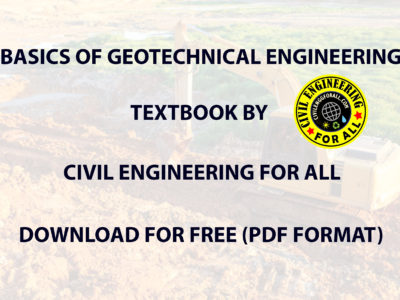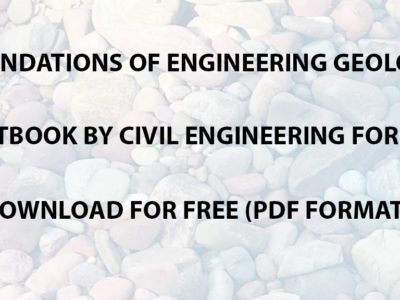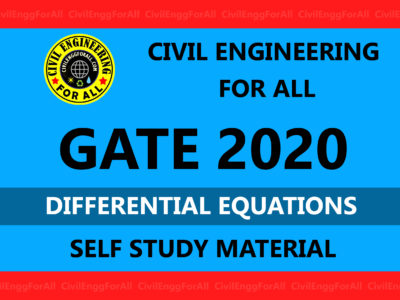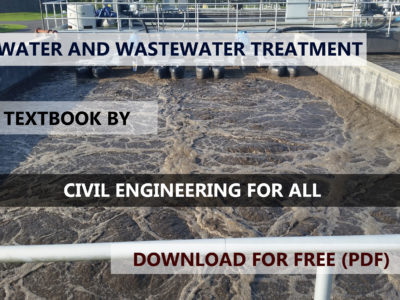
CONTENTS
- Classification of Water Present in Soil
- Duty
- Delta
- Base Period
- Crop Period
- Factors Affecting Duty
- Water Requirement of Crops
- Consumptive Use of Water (Evapo-Transpiration)
- Inflow and Outflow Studies for Large Area
- Irrigation Efficiency
- Principle Crops
- Determination of Irrigation Requirement of Crops
- Design of Channels
- Diversion Head Works
- Canal Fall
- Spillways
- Design of Weirs and Barrages
- Safety of Hydraulic Structures
- Khosla’s Theory and Concept of Flow Nets
- Irrigation Methods
- Surface Irrigation
- Sub-Surface Irrigation
- Sprinkler Irrigation
- Water Logging and Drainage
- Land Drainage
- Drainage Area
- Size of Tile Drains

Irrigation may be defined as the process of supplying water to soil for rising crops, or is generally defined as the application of water to soil for supplying the moisture essential for plant growth.
Types of Irrigation
1. Surface irrigation 2. Subsurface irrigation
Surface irrigation can be further classified into
(a) Flow irrigation: In this types of irrigation, the supply of irrigation water available is at such a level that it is conveyed on to land by gravity flow.
(b) Lift irrigation: In this type of irrigation, the water is lifted up by mechanical means. Irrigation from well water is a example. Flow irrigation is divided in two types:
- Perennial system: In this constant & continuous water supply is done to crops as per requirement during crop-period. When perennial system of irrigation is carried out by canal system, it is called ‘Direct Irrigation’. When perennial system of irrigation is carried out by storage reservoirs, it is called ‘Storage irrigation’.
- Flood irrigation: In this soil is kept submerged & flooded with water. Moisture sealed with occasional supplement of natural rainfall brings crops to maturity.
2. Sub surface irrigation: It is divided in two types.
- Natural sub irrigation: Water leaked from channels causes rise of water table, which in turn provides water to crops through capillarity is termed as natural sub irrigation.
- Artificial sub irrigation: When a system of open jointed drains is artificially laid below soil, so as to supply water to crops by capillarity, then it is known as Artificial sub surface irrigation.
CLASSIFICATION OF WATER PRESENT IN SOIL

- Hygroscopic Water – When an oven dried sample is kept open in the atmosphere, it absorbs some amount of water from the atmosphere. This is called hygroscopic water, and is not capable of movement by the action of gravity or capillary forces.
- Capillary Water – This is the part in excess of the hygroscopic water which exists in the pore spaces of the soil by molecular attraction
- Gravitational Water – This is that part in excess of hygroscopic and capillary water which will move out of the soil if favourable drainage is provided.
IES MASTER CIVIL ENGINEERING GATE STUDY MATERIALS PDF: DOWNLOAD LINK
ACE ACADEMY CIVIL ENGINEERING GATE STUDY MATERIALS PDF: DOWNLOAD LINK
SATURATION CAPACITY (or Maximum holding capacity/Total capacity)
It is the amount of water required to fill all the pore spaces between soil particles by replacing all air held in pore spaces. It is the upper limit of possible moisture content when porosity of soil is known, the saturation capacity can be expressed as equivalent cm of water per meter of soil depth.
- DUTY (D) – Irrigation capacity of a unit of water, or it is the area irrigated in hectares by 1cumec of discharge flowing throughout the base period {hect/cumec}.
- DELTA (Δ) – It is the total depth of water required by a crop during the entire period, the crop is in the field {cm or m}
- BASE PERIOD (B) – It is the time interval in days between first watering given prior to sowing and the last watering before harvesting (days).
- CROP PERIOD – It is the time interval between sowing and harvesting of crop (days).
FACTORS AFFECTI NG DUTY
1. Method and System of Irrigation
- Perennial or Permanent system -> high duty
- Inundation system ->low duty as wasteful use of water.
- Flow system ->low duty as conveyance losses are high.
- Lift irrigation ->high duty as commended area of each well is very near to it.
2. Mode of Applying Water
Flood irrigation ->less duty than furrow system
Sub-irrigation ->higher duty.
Basin irrigation and Uncontrolled flooding -> low duty.
3. Method of cultivation – Land is made loose by ploughing ->more duty
4. Time and Frequency of tilling – When soil is in good filth (structure), evaporation losses are less, soil becomes properly aerated ->duty is high.
5. Type of crop
6. Base Period of crop It’s base period is high, duty is low and vice versa.
7. Climatic condition of the area
- Temperature->high temperature ->low duty
- Wind ->high wind ->low duty
- Humidity ->high humidity ->high duty
- Rainfall ->increase duty
8. Quality of Water
(i) Harmful salt and alkali content decrease duty
(ii) Fertilizing matter in water increase duty.
9. Method of Assessment
- Volumetric method ->more duty (economical use of water)
- Crop rate or area basis ->less duty (more water to be used)
10. Canal Condition
- Earthern canal ->low duty due to more seepage and percolation losses.
- Lined canal ->high duty due to less losses
- If canal is so aligned that irrigated areas are concentrated along it ->duty will be higher and vice versa.
11. Character of soil and Sub soil of the canal
- Coarse grained permeable soil -> less duty as more seepage and percolation.
- Fined grained soil -> losses are less, so high duty.
12. Character of soil and sub soil of the irrigation field
- Coarse grained – percolation losses are high, so less duty.
- Topography: it also affects the duty.
Methods of Improving Duty
- Suitable method of applying water to the crop should be used.
- Land should be properly ploughed and levelled before sowing the crop. It should be given good filth (structure)
- The land should be cultivated frequently since frequent cultivation reduces loss of moisture, specially when the ground water is within capillary reach of ground surface.
- Canal should be lined. This reduces seepage, percolation losses and evaporation losses also.
- Parallel canal should be constructed so that F.S.L. will be lowered and thus losses will also be reduced.
- Idle length of canal should be reduced.
- Alignment of the canal either in sandy soil or in fissured rock should be avoided.
- Canal should be so aligned that the areas to be cultivated are concentrated along it.
- Source of water should be such that it gives good quality of water.
- Rotation of crops must be practiced.
- Volumetric method of assessment should be used.
- Farmers must be trained in the proper use of water so that they apply correct quality of water at correct timing.
- The land should be redistributed to the farmers so that they get only as much land as they are capable of managing it.
- Research stations should be established to study the soil, the seed and conservation of moisture.
- Canal staff should be efficient, responsible and honest.
ACE ACADEMY CIVIL ENGINEERING GATE HANDWRITTEN CLASSROOM NOTES PDF: DOWNLOAD LINK
MADE EASY CIVIL ENGINEERING GATE HANDWRITTEN CLASSROOM NOTES PDF: DOWNLOAD LINK
Factors Affecting Irrigation Efficiency
- Irregular land surface.
- Shallow soils underlain by gravels of light permeability.
- Either very small or excessively large irrigation stream.
- Non-attendance of water during irrigation
- Long irrigation runs.
- Wrong irrigation methods.
- Improper preparation of land.
- Compact impervious soil.
- Steep slopes of land surface
- Excessive single application
PRINCIPLE CROPS

- Kharif Crops: These are sown by the beginning of south west monsoon and are harvested in autumn.
- Rabi crops: These are sown in autumn and are harvested in springs
- Wet crop: These requires water for irrigation.
- Dry crops: These does not require water for irrigation
- Garden crops: These requires irrigation throughout the year.
Lacey’s Theory
On the basis of his research work, Lacey found many drawbacks in Kennedy’s Theory and put forward his new theory.
Lacey’s Regime Channels

According to him, a channel which is under ‘initial regime’ is not a channel in regime (though outwardly it appears to be in regime as there is not silting or scouring) and hence, regime theory is not applicable to them. His theory is applicable only to channels which are in ‘true regime’ or ‘final regime’.
1. Initial regime – When only bed slope of a channel varies and its cross-section or wetted perimeter remains unaffected, even then channel can exhibit no silting no scouring properties, called initial regime. When water flows through an excavated channel with some what narrower dimensions and defective slopes, then silt carried by the water gets dropped in the upper reaches, thereby increasing channel bed slope. Consequently, velocity is increases and a non-silting equilibrium is established, called initial regime. Sides of such channels are subjected to a lateral restraint and could have scoured if bank soil would have been a true alluvium. But in practice, they may either get grassed or be of clayey soil and, therefore, they may not get eroded at all. Hence, such channels will exhibit ‘non-silting non scouring’ properties, and they will appear to be in regime, but in fact they are not. They have achieved only a working stability due to rigidity of their banks. Their slopes and velocities are higher and cross-sections narrower than what would have been if the sides were not rigid. Such channels are called channels in initial regime and regime theory is not applicable to them as they are infact, not the channels in alluvium.
2. Final regime – Channel shape carrying medium size silt Channel shape carrying fine silt Channel shape carrying coarse silt If there is no resistance from the sides and all the variables such as perimeter, depth, slope, etc are equally free to vary and finally get adjusted according to discharge and silt grade, then the channel is said to have achieved permanent stability called final regime. Regime theory is applicable to such channels only, and not to all regime channels (including initial regime) as was envisaged by Kennedy. Such a channel in which all variables are equally free to vary, has a tendency to assume a semi-elliptical section. The coarser the silt, flatter is the semi-ellipse, i.e. greater is width of the water surface. The finer the silt, the more nearly the section attains a semicircle.
3. True Regime – A channel shall be in regime, if there is neither silting nor scouring. For this condition to be satisfied, the silt load entering the channel must be carried through by the channel section. Again, since there is only one channel section and one bed slope at which the channel carrying a given discharge will carry a particular type of silt. Hence, an artificially constructed channel having a certain fixed section and a certain fixed slope can behave in regime only if following conditions are satisfied:
- Discharge is constant.
- Flow is uniform.
- Silt grade and silt charge is constant, i.e. amount and type of silt is the same.
- Channel is flowing throughout a material which can be scoured as easily as it can be deposited (such soil is called incoherent alluvium and is of the same type as is transported.
In practice, all these conditions can never be satisfied, and therefore artificial channels can never be in ‘true regime’, they can either be in initial regime or final regime.
DIVERSION HEAD WORKS
The works, which are constructed at the head of the canal, in order to divert the river water towards the canal, so as to ensure a regulated continuous supply of silt-free water with a certain minimum head into the canal, are called diversion head works.

Diversion Weir and Barrage
If major part or entire ponding of water is achieved by a raised crest and a smaller part or nil part of it is achieved by the shutter, then this barrier is called weir. If most of the ponding is done by gates and a smaller or nil part of it is done by the raised crest, then this barrier is called barrage or river regulator. Barrage gives less afflux and a better control upon the river flow because inflow and outflow can be controlled to a much greater extent by a suitable manipulation of its gates. Diversion weir is a raised pucca structure with or without shutters and laid across the river width. Entire length of the weir is divided into a number of bays by means of divide piers so as to avoid cross-flow in floods.
ACE ACADEMY GATE CLASSROOM NOTES PDF: CLICK HERE
MADE EASY GATE CLASSROOM NOTES PDF: CLICK HERE
Types of Weirs
(i) Masonry weir with Vertical drop: Particularly suitable for hard clay and consolidated gravel foundation. However, this type of weir is obsolete.

(ii) Rock-fill weirs with Sloping aprons: It is the simplest type of construction and is suitable for fine sandy foundations like those in alluvial areas in North India. However with the development of concrete glacis weirs, the above type also becomes obsolete.

(iii) Modern Concrete Weirs with Sloping downstream glacis: Weir of this type are of recent origin and their design is based on modern concepts of sub-surface flow (i.e. Khosla’s theory). The hydraulic jump is formed on the downstream sloping glacis, so as to dissipate the energy of the flowing water. This type of weirs are exclusively used, especially on permeable foundations, and are generally provided with a low crest and counter-balanced gates, thus, making it a barrage.

Afflux Rise in the maximum flood level (HFL) upstream of the weir, caused due to construction of the weir across the river, is called afflux. Pond level Water-level required in the under-sluice pocket upstream of the canal head regulator, so as to feed the canal with the full supply, is called pond level. Since weir crest is raised upto the pond level, a minimum water level equal to pond level is always maintained in the undersluice pocket, so as to ensure a continuous supply of water into the canal with its full supply level. Thus available head at the canal head regulator is equal to differ ence of the pond level and canal FSL.
Pond level
Water-level required in the under-sluice pocket upstream of the canal head regulator, so as to feed the canal with the full supply, is called pond level. Since weir crest is raised upto the pond level, a minimum water level equal to pond level is always maintained in the undersluice pocket, so as to ensure a continuous supply of water into the canal with its full supply level. Thus available head at the canal head regulator is equal to difference of the pond level and canal FSL.
Under -Sluices or Scouring Sluices
These maintain a deep channel in front of the head regulator and dispose off heavy silt and a part flood discharge on the downstream side of the barrage.
Functions
- Preserve a clear and defined river channel approaching the regulator.
- Control the silt entry into the canal.
- Scour the silt deposited in the river bed above the approach channel.
- Pass the low floods without dropping the shutter of the main weir.
- Provide greater water-way for floods, thus lowering the flood levels.
Design consideration
Silt of the under-sluice pocket is kept at or slightly above the deepest river bed and about 0.9 to 1.8 metres below silt of the canal head regulator.
Divide Wall or Groyne
Divide wall is a masonry or concrete wall constructed at right angle to the axis of the weir, and separates the weir proper from ‘under-sluices’. Divide wall extends on the upstream side beyond the beginning of the canal head regulator, and on the downstream side, it extends up to the end of loose protection of the under-sluices.
Functions
- It separates ‘under-sluice’ from the weir proper, since crest level of the under-sluices is lower than that of the weir proper, the two must be separated, and this is being done by the divide wall.
- It helps in providing a comparatively less turbulent pocket near the canal head regulator, resulting in deposition of silt in this pocket and, thus, help in entry of silt free water into the canal.
River Training Works
These are required near the weir site in order to ensure a smooth and a axial flow of water, and thus, to prevent the river from outflanking. River training works required on a Canal Headworks:
- Guide Banks: It forces the river into a restricted channel
- Marginal Bunds: These are provided on the upstream side of the works in order to protect the area from submergence due to rise in HFL. These are nothing but earthen embankment, protected by groynes, wherever needed.
- Spurs or Groynes
IRRIGATION ENGINEERING IES MASTER GATE STUDY MATERIAL PDF: CLICK HERE
IRRIGATION ENGINEERING ACE ACADEMY GATE STUDY MATERIAL PDF: CLICK HERE
Fish Ladder
A structure which enables the fish to pass upstream is called fish ladder. It is a device by which flow energy can be dissipated in such a manner as to provide smooth flow at sufficiently low velocity, not exceeding 3 to 3.5 m/s. This object is generally accomplished by providing a narrow opening adjacent to the divide wall and provide suitable baffles or staggering device in it, so as to control the flow velocity.
Canal Head Regulator (CHR) or Head Sluices
This is provided at the head of the off-taking canal. A head regulator may consist of a number of spans separated by piers and operated by gates similar to that provided in a barrage.

Functions
- It regulates supply of water entering the canal.
- It controls entry of silt in the canal.
- It prevents river floods from entering the canal.
Water from the under-sluice pocket is made to enter the regulator bays, so as to pass full supply discharge into the canal. Maximum height of these gated openings called head sluice will be equal to the difference of pond level and crest level of the regulator. The entry of silt into the canal is controlled by keeping crest of the head regulator by about 1.2 to 1.5 m higher than crest of the under-sluice.
Types of Regulations
There are two methods of regulation adopted at a head regulator to control entry of silt into the canal.
(i) Still Pond Regulation: In this method, the pocket sluices are entirely closed and canal draws water from the still pond in the pocket. The water in excess of the canal requirement is thus not allowed to escape under the sluice gates. Velocity of water in the pocket is very much reduced on account of excessive water way since only supply required for the canal enters the pocket. Thus silt is deposited in the pocket and clear water enters the canal. When silt deposited has a level about ½ to 1m below the crest level of the regulator, supply in the canal is shut off for about 24 hours and sluice gates are opened to scour deposited silt and discharge it downstream. The process is repeated.
(ii) Open Flow Regulation: In this system, under sluices may be kept open so that river supply in excess of the canal requirements is escaped. Top water passes into the canal while bottom water maintains a certain velocity in the pocket to keep the silt to remain in suspension. The advantage of this system is that the canal is not to be closed for scouring the silt.
IRRIGATION ENGINEERING CIVIL ENGINEERING GATE 2020 STUDY MATERIAL FREE DOWNLOAD PDF
DOWNLOAD LINK : CLICK HERE
PASSWORD : CivilEnggForAll
OTHER USEFUL BOOKS
- CIVIL ENGINEERING TEXTBOOKS WITH DOWNLOAD LINKS
- IES MASTER CIVIL ENGINEERING GATE STUDY MATERIALS PDF
- ACE ACADEMY CIVIL ENGINEERING GATE STUDY MATERIALS PDF
- RAJASTHAN STAFF SELECTION BOARD (RSSB) JUNIOR ENGINEER DIPLOMA CIVIL ENGINEERING EXAM 2022 – HINDI & ENGLISH MEDIUM SOLVED PAPER – FREE DOWNLOAD PDF (CivilEnggForAll.com)
- ISRO TECHNICAL ASSISTANT EXAM 2022 – CIVIL ENGINEERING – HINDI & ENGLISH MEDIUM – SOLVED PAPER – FREE DOWNLOAD PDF (CivilEnggForAll.com)
- MADHYA PRADESH PUBLIC SERVICE (MPPSC) COMMISSION – ASSISTANT ENGINEER EXAM – MPPSC AE 2021 CIVIL ENGINEERING – SOLVED PAPER WITH EXPLANATIONS – PDF FREE DOWNLOAD
- BIHAR PUBLIC SERVICE COMMISSION (BPSC) ASSISTANT ENGINEER EXAM – 2022 – CIVIL ENGINEERING – SOLVED PAPER – FREE DOWNLOAD PDF (CivilEnggForAll.com)
- ODISHA PUBLIC SERVICE COMMISSION – OPSC AEE PANCHAYATI RAJ EXAM 2021 – SOLVED PAPER WITH EXPLANATION – FREE DOWNLOAD PDF





















